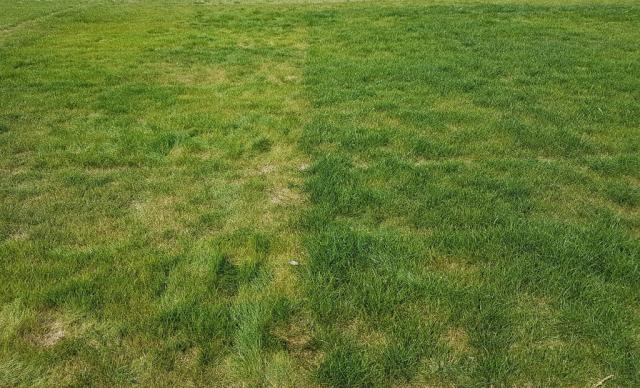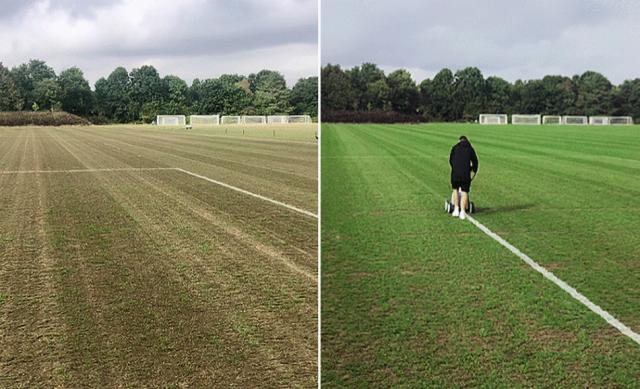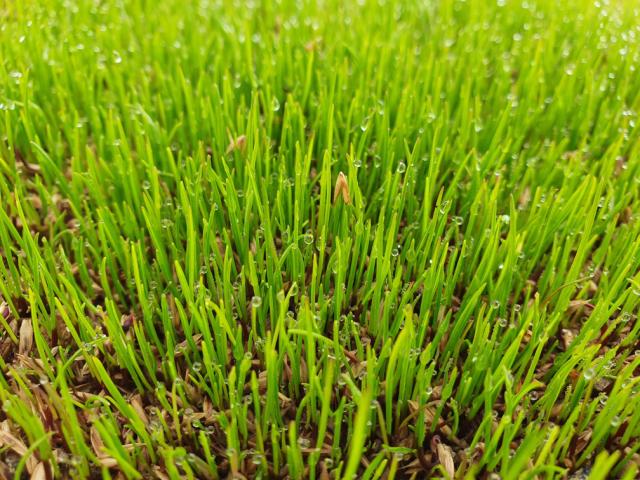❄️ Cold Droughts: The Invisible Stress
This isn’t just another dry spell. We’re in a cold drought — a challenging combination of dry, breezy warm days, frosty nights, and soil temperatures stuck stubbornly below optimum. For both grass and seed, it’s disorienting. Early irrigation has been switched on across the UK, but watering cold soils — especially from deep borehole systems — often delays germination rather than encouraging it. Most species need sustained soil temperatures above 8–10°C to make a meaningful move.
Layer in legacy issues from last autumn (leatherjackets, Fusarium scars, surface compaction), and many managers are looking out across turf that feels fragile and reluctant.
But understanding the why can shape the right next step.

🌾 Know Your Species — Know Their Limits
Different species respond differently to environmental stress. Smart seed choices reflect that.
- Perennial ryegrass – Fast in ideal conditions, but even elite amenity types like Chloé and Clementine stall in cold soil.
- 4turf® Tetraploid ryegrass (Fabian) – Designed for stress. Deeper roots, faster recovery, and excellent early season performance. A smart choice for spring overseeding, especially on winter sports turf.
- Fescues – Resilient but patient. Orionette and Sybille need moisture and time to show their best — more suited to autumn establishment.
- Bents – High performance, Arrowtown, Manor, Cleek offer elite quality but need warm soils and care in early stages.
Seed success isn’t just about what’s in the bag — it’s about what’s underfoot.

🌱 To Seed or Not to Seed?
It’s the question we’re asked daily: Should I seed now? Or wait?
The truth is, dry seed in dry soil doesn’t fail — it waits. That’s one of the advantages of high-quality grass seed: its natural dormancy is a built-in buffer. But successful seeding isn’t just about moisture at sowing — it’s about confidence in post-germination care. So ask yourself:
- Will I be able to maintain moisture once germination begins?
- Can I support establishment through the first 14–21 days?
If yes — proceed strategically:
- Use wetting agents to prepare soil for rainfall.
- Light scarify to remove surface debris and improve seed contact.
- Delay deeper renovation until natural moisture returns — often late summer into autumn.
🧠 Turf Tells You What It Needs
Seeing poa annua seedheads flush early? That’s not just seasonal — that’s stress. These are your surface’s "help me" zones. Use them as visual indicators to guide targeted overseeding, aeration, and nutrient support. They're also ideal areas to introduce high-performance cultivars that can shift species balance toward longer-term resilience.
🌿 Performance, Proven Under Pressure
At DLF, performance isn't just a promise on a label — it's a result of relentless testing, science-led breeding, and practical application.
Our Radimax root-screening facility, the largest of its kind in Europe, is at the heart of this commitment. Here, every new DLF grass cultivar is subjected to controlled trials that mimic real-world challenges — including drought stress, nutrient limitation, and low-input management. This allows us to observe and select grasses not just for visual quality, but for how they cope when conditions are at their toughest.
What does that mean for turf managers?
It means using seed that has been proven to:
- Root deeper, accessing moisture and nutrients other grasses can’t
- Use inputs more efficiently, reducing fertiliser and irrigation needs
- Recover faster after wear or environmental stress
- Remain playable and consistent, even when the weather or budget isn’t
Whether it’s on the pitch, the green, or the boundary, DLF grasses are built to withstand pressure — and help you perform under it too.
💧 Stress Now, Strain Ahead – Playing the Weather
Cold, dry turf isn’t hungry — it’s thirsty. Right now, soil temperatures are low, evapotranspiration is high, and moisture is scarce. In these conditions, turf plants shut down nutrient uptake, so heavy fertiliser applications do little more than burn budgets and increase plant stress.
But this isn’t just about now. If the dry spring rolls into a hotter, harsher summer, turf already under pressure could face long-term decline: weakened swards, reduced recovery, and greater vulnerability to wear and drought damage. That’s why this season isn’t about forcing growth — it’s about reading the forecast, being patient, and making the most of short-lived weather windows.
In practice, that means:
- Watching for periods of warmth and rainfall, even if brief — and using them to your advantage
- Using wetting agents in advance to help soils respond when moisture finally arrives
- Applying light foliar feeds or biostimulants to nudge growth gently, without shocking the plant
- Avoiding deep stress inducing renovation work until there’s confidence in follow-up rainfall or irrigation support
It’s a balancing act — between holding back and acting fast when the conditions are right.
The best turf managers aren’t just reactive; they’re adaptive. And always consult your agronomist — because the best results come from joined-up thinking. Our seed performs best within a wider turf management plan.
🚜 From Fields to Pitches – The Wider Picture
This spring has challenged not just turf managers, but turf growers and our Breeders too. If turf grasses and wildflowers are dry and struggling with limited growth, then so are the fields of our breeders waiting for this years harvest. New sowings are on hold, irrigation demands are high, and early stress is already showing in seed production fields — from Denmark to Yorkshire.
We’re not ringing alarm bells, but early planning is smart planning. If you’re targeting summer or autumn renovations, talk to us now. The best cultivars are always in demand — especially when conditions tighten supply.
💬 Final Thought: Resilience Over Reaction
This spring has tested us. But it also reminds us what great turf management is really about: resilience, not reaction.
Don’t overfeed in search of growth that won’t come. Don’t seed just to be seen to act. Instead:
- Ensure your soil is receptive.
- Know your watering window.
- Choose seed with proven performance.
The grass is down — but not out. If the summer turns hotter and drier, this early damage could become critical. But play it smart now, and you’re not just surviving — you’re setting up to thrive.
The warmth will come. The rain will follow.
And when it does — make sure your turf is ready. With seed you can trust. With support you can count on. With DLF Seeds UK — your partner in performance.

DLF is proud to produce a comprehensive range of professional seed solutions, including Johnsons Sports Seed, Masterline, MM, and Designer for turf, alongside our ProFlora and Colour Boost wildflower ranges for ecological and landscape enhancement.